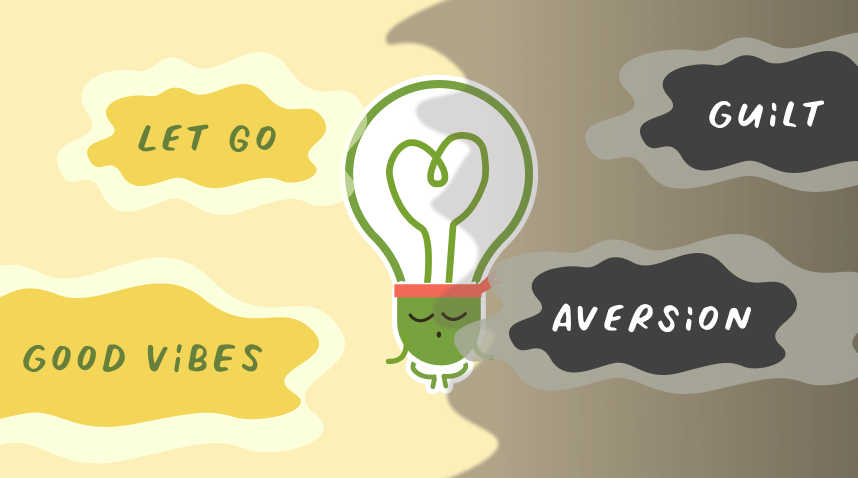TLDR: As “spiritual people” we might go through difficult events thinking we have transcended them – but actually, it may have just been spiritual bypass. To truly let something go, we must first find a way to meet ourselves and our suffering.
A phenomenon I’ve often observed within me is spiritual bypass. According to clinical psychologist John Welwood, this is the tendency to use spiritual explanations and practices to avoid facing unresolved emotional issues and psychological wounds.
Why It’s Problematic

With spiritual bypass, we may go through something traumatic and then pick out a line of Dhamma and think, “Yeah, the Buddha said this and he’s right, so I should get over it now.”
For example, say someone close to you has passed away. Spiritual bypass in this situation may look like telling yourself that “everything is impermanent” and that “death is natural, it happens to everyone” so “I shouldn’t feel grief”.
You use the Dhamma to rationalise the grief away – but without healthily processing the emotions that naturally arise.
This is problematic because externally, it may appear like you’ve been able to transcend the suffering, completely unaffected – but you haven’t actually done the real work of processing the painful experience and unpleasant emotions that come with it.
Without properly taking the time to receive these things and truly let them go, they might stay repressed, festering away until they come back to bite you in the a** later on.
I’m Buddhist, so I Should Just Get Over It

Something that can make this tendency worse is a strong attachment to “being Buddhist”. You may hold yourself to very high standards, putting pressure on yourself to “be strong” and “get over it”, thinking you need to be unfazed by suffering.
“I am Buddhist, so I shouldn’t be angry. Instead, I should be contented.”
“I am Buddhist, so I should be beyond such petty emotions.”
“I am Buddhist, so I should be able to let go of suffering.”
From my experience, this can be a kind of conceit. It’s a deluded expectation stemming from a heavy attachment to a “Buddhist identity” – an idealism about how your practice “should” look like, instead of working with what actually arises.
You may feel guilt or aversion around the unwholesome thoughts, intentions and desires that inevitably arise. And because of the shame, you want to hide them away, from others and even from yourself.
But what happens when you don’t allow yourself to process all that?
It doesn’t just disappear. Instead, it gets buried in the heart and resurfaces later on.
In my late teens, I experienced several traumatic events and at the time, spiritually bypassed them and then left to study abroad (which was a niceee, biiig distraction).
Years later, when I returned home during the pandemic to familiar conditions with lots of quiet, idle time, many of those unresolved negative emotions and thought patterns began to resurface.
It was surprising because for the last three years I thought I was “fine” for the most part. But evidently, I had just swept things into “the basement of unawareness”. Now that they’d reappeared, it was time to clear out the basement – to finally meet myself and deal with the repressed suffering.
This was important because, as Pema Chödrön says, “Nothing ever goes away until it has taught us what we need to know”.
So, How Should We Approach Suffering?

We know that everything is impermanent. We know that everything decays and dies one day.
We often know the Dhamma very well on an intellectual level.
But if intellectual understanding was all it took to let go, then everyone would be enlightened, wouldn’t they?
How do we apply the Dhamma beyond just a conceptual level?
In Thai, one of the terms for the mind is jit jai – “mind and heart”. There’s an ambiguity in the language that likens the mind to the heart. To me, this seems to say that processing things up in the head is not enough – we must also deal with them on an emotional level.
One of my favourite authors, Yung Pueblo, says “Manage your reactions, but do not suppress your emotions.”
Certainly, if there is, say, anger in the heart, we should take care to ensure that it doesn’t leak into our actions and speech in a way that harms ourselves and others. We might have to suppress it for that little while, but then we should make sure to process it healthily later on – this is necessary so that it can really be let go of.
Of course, this sounds straightforward in theory, but it takes a lot of skill to acknowledge these emotions without indulging in or avoiding them.
One way I practice receiving negative emotion is by being mindful of how it feels in the body. Focusing on how anger physically feels and changes helps me to receive it without indulging in it or denying it. However, I find this difficult to do for certain emotions (e.g. depression, which tends to lure you in and make you want to wallow in it), if I have a strong attachment to the issue at hand, or if my mindfulness is weak at that time.
Apart from mindfulness, the Buddha recommends five ways to remove distracting thoughts, which you can read about here. What works for you may depend on your temperament.
Letting Go of Repressed Dukkha
A process I find effective for dealing with old negative emotions is this:
1. Returning to familiar conditions in which the trauma took place can cause these old emotions to resurface. So if a situation is too triggering, remove yourself from it to prevent unwholesome speech and action.
2. Find a way to calm down. Interestingly, Ajahn Munindo suggests that meditation might not be that helpful at this time. If you’re completely agitated but try to meditate, you might just be mentally proliferating the whole time. Or you might just be tranquillizing yourself and not feeling your emotions – making it a form of spiritual bypass! What has worked for me is doing something physical with that energy, such as taking a long walk.
3. When you’re calm enough, receive the emotion. Let yourself feel all of it. If you need to cry, cry. If you need to vent, do it with a trustworthy friend. I remember a story by Ajahn Sumedho, who had so much aversion towards a particular visitor to the monastery that he sat down one day and just began writing out all his anger –completely unfiltered, not trying to be nice or reasonable or “a good monk” – until there was none left. This is acceptance and release.
4. I find that receiving the emotion comes hand-in-hand with developing insight around it. When your mind is calm enough to look at the situation, you may develop new perspectives and understandings. These “paradigm shifts” are the real good stuff that helps to create lasting “liberation” from the issue. Bit by bit, they help you make sense of the experience and let go of it.
For me, this process usually takes place over a few days. You may also find that you have to go through it multiple times. That’s because, after some time, these habitual mindsets that we carry can become cemented in the psyche, becoming our “default mode”. Reframing these thoughts can thus be very challenging – so don’t be afraid to even seek guidance from a therapist.
To quote Yung Pueblo again, “If the pain was deep, you will have to let it go many times… Letting go is not a one-time event, it is a habit that requires constant repetition to become strong. Sometimes the reaction to the pain is so deep that you will have to observe and release the tension repeatedly to fully cleanse the wound.”
With each cycle, you might find that you let go a little bit more.
Wise Steps:
- If you realise that something within your heart is unresolved, the first step is to let it come to the surface. Practice loving-acceptance.
- Recognise your triggers and set boundaries for yourself. If certain situations are too much to handle, remove yourself from them. When you feel stronger, you may test the waters further in the future – but for now, protect your mind.
- Having to deal with old trauma may feel like you’re regressing, but it is actually progress. Be patient and kind with yourself throughout this (often painful but rewarding) process.


